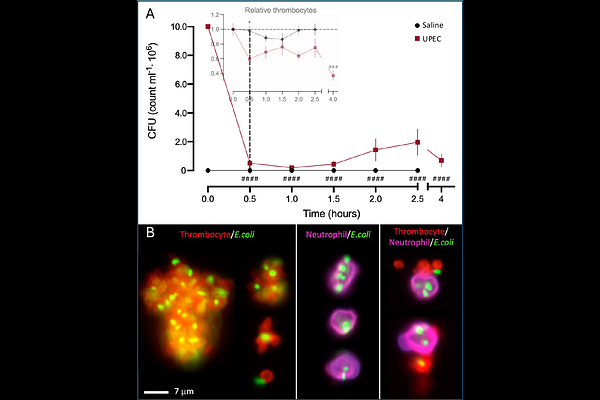Platelet-dependent clearance of uropathogenic Escherichia coli directly drives sepsis-induced thrombocytopenia in a mouse model

Platelet-dependent clearance of uropathogenic Escherichia coli directly drives sepsis-induced thrombocytopenia in a mouse model
Johnsen, N.; Christensen, M. G.; Sparsoe, L. V.; Lambertsen, E. H.; Corydon, T.; Praetorius, H.
AbstractThrombocytopenia is a distinct negative prognostic marker in sepsis, a trait associated with the procoagulatory state of severe infection. However, thrombocytes have transcended to encompass a modulatory role in the immune response and as pathogen scavengers. In a murine model of urosepsis, we observed a substantial drop (40%) in circulating thrombocytes already 30 minutes after the introduction of uropathogenic Escherichia coli (UPEC) and a concomitant transient increase in both platelet factor 4 release and thrombin-antithrombin complexes. This reduction in thrombocytes was timely associated with a reduction in circulating UPEC. By imaging flow cytometry, we visualized that eGFP-expressing UPEC was instantly bound to circulating thrombocytes, leading to the immediate removal of thrombocyte-UPEC complexes and a 95% reduction in bacterial load within 10 minutes. We demonstrate that thrombocyte-UPEC complexes are cleared primarily through the liver, engaging the sinusoidal endothelial cells. The majority of the UPEC are recovered in the liver, with minimal contribution from intravascular bacterial damage or lysis. The thrombocyte-dependent clearance system has a maximal capacity, and overload markedly challenges the intravascular UPEC-clearance. The data strongly suggest that circulating thrombocytes constitute the most important cell type for fast scavenging and clearance of invading bacteria during urosepsis and demonstrate that thrombocytopenia can be a direct function of bacteremia with UPEC.